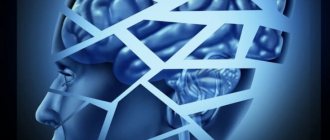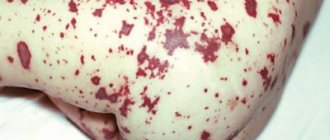More useful information about other various types of diseases starting with the letter “M”: Lesser chorea, Slow infections of the central nervous system, Medulloblastoma, Herniated disc, Thoracic disc herniation, Lumbar disc herniation, Cervical disc herniation, Intercostal neuralgia, Meningeal syndrome, Meningioma, Meningitis , Meningococcal meningitis, Meningomyelitis, Meningoencephalitis, Metabolic myopathy, Metastatic brain tumors, Metachromatic leukodystrophy, Weather sensitivity, Myasthenia gravis, Migraine stroke.
Meningeal syndrome: concept
Meningeal syndrome (MS) is a symptomatic complex that occurs when there are abnormalities in the cerebral surfaces. The presented disease can manifest itself when infectious microorganisms enter the body, intoxication with chemicals, problems with blood vessels, diseases of a liquor-hypertensive nature, damage and anomalies of carcinomatous etiology. The main factors characteristic of MS are the presence of pain in the head, muscle rigidity, gag reflexes, hyperesthesia and algic phenomena.
The basis of the research is clinical indicators and reports after analysis of the spinal substance. The treatment plan is based on the etiology of occurrence. Mostly doctors prescribe medications that have antiviral, antifungal, and antiprotozoal effects. In addition, symptomatic relief and stabilization of intracranial pressure are prescribed.
brief information
Meningeal disorder is a common disease that occurs quite often in the practice of doctors in the field of neurology, pediatrics, otolaryngology and other specializations. Translated from Latin, the name of the pathology means “brain membrane.” There is a type of MS when irritation of the cerebral cavity occurs without inflammatory processes; it is called in medical practice - meningism.
A large number of discoveries, information and rare facts were made back in the 19th century. The disease was studied by many scientists around the world, who eventually offered specific descriptions of the symptoms of the disease. The concepts are currently in use. One of the nuances of a neurological disorder is the inaccurate clinical picture of the disorder in the retirement age population.
Causative agents of meningeal syndrome
Intracranial disorders and multisystem anomalies become harmful causes. Often, MS provokes the progress of the inflammatory process occurring in the brain structures (meningitis), subarachnoid bleeding, and head injury. In accordance with the effect on the cerebral membranes, etiological sources are divided into two categories: inflammatory and non-inflammatory.
First group:
- Bacterial origin: nonspecific (caused by the entry into the body of meningococcal infection, Haemophilus influenzae, pneumococci, and in infants - Escherichia coli and salmonella), specific (begins when pathogenic elements of tuberculosis and syphilis appear in the departments).
- Viral origin - in almost 75% of diagnosed cases, they develop with the participation of enteroviruses, in rare situations - adenovirus, herpetic infection, tick-borne encephalitis, etc. The main factors are microorganisms of cryptococcal, candida, and histoplasmic nature (provoking severe inflammatory foci with petechial hemorrhage).
- Protozoal origin - the main sources are toxoplasmosis and malaria.
Second group:
- A large accumulation of blood cells in the brain structures (appear as a result of an acute malfunction in the circulatory system, severe arterial hypertension, skull injuries, cerebral vasculitis).
- Intracranial hypertension is a consequence of hydrocephalus, neoplasms (formation of a malignant or benign tumor, intracranial cyst, abscess, hematoma).
- Poisoning: exogenous type - paints and varnishes are provocateurs, bad habits such as substance abuse or alcohol addiction, endogenous type - uremia, hypoparathyroidism are considered causative agents.
- Neurotoxic origin in general infections - seasonal influenza, dysentery, colds, etc.
- Carcinomatous origin - complications after infiltration of the cerebral membranes by cancer cells during cancer processes (including the leukocyte type of infiltration in neurolecosis disease).
General information
Meningeal syndrome is a complex of symptoms that reflect diffuse damage to brain tissue (brain and spinal cord). Manifestations typical of meningitis of infectious etiology are often observed in various pathologies that are accompanied by irritation of the membranes covering the brain (brain, spinal cord).
A condition not associated with an inflammatory process, accompanied by meningeal signs, is called meningism. Characteristic symptoms appear in pediatric patients with the following diseases:
- Inflammatory processes affecting organs located in the chest area.
- Infectious lesions of the upper respiratory tract.
- Infections of the gastrointestinal tract, which are accompanied by the process of neurointoxication (specific symptoms develop due to increased intracranial pressure and irritation of meningeal receptors).
In the above cases, there are no traces of inflammatory processes in the cerebrospinal fluid obtained as a result of a lumbar test. In patients of any age, typical manifestations of meningitis can occur in the following cases:
- Hemorrhage into the subarachnoid space.
- Tumors localized in the brain tissue (mainly in the brain stem or in the area of the posterior fossa of the skull).
- Tuberculosis.
- Intoxication with chemicals, carbon monoxide.
- Traumatic brain injury (as a result of concomitant swelling of brain tissue).
- Acute disorders of cerebral blood flow.
The meningeal symptom complex can appear due to prolonged insolation, due to overheating of the head and body, against the background of arterial hypertension. Meningeal syndrome is a symptom complex where the characteristic signs are united by a common pathogenesis, which, with an infectious etiology, is based on an increase in intracranial pressure and inflammatory infiltration of the membranes.
With meningism, intracranial pressure increases due to overproduction or impaired outflow of cerebrospinal fluid. In this case, swelling of the brain structures and membranes plays an important role in the occurrence of meningeal symptoms. Meningeal signs can appear with ARVI, influenza, hepatitis of viral etiology, pneumonia, dysentery, with exacerbation of somatic diseases that occur in a chronic form. Meningitis of infectious origin is provoked by:
- Bacteria (meningococcus, staphylococcus, pneumococcus).
- Viruses (paramyxovirus, Rubella virus).
- Fungi (candida, Cryptococcus neoformans).
- Protozoa microorganisms (amoeba, toxoplasma).
Unverified (unconfirmed etiology) primary diagnosis of meningitis is made based on the totality of the syndromes present - meningeal (meningeal), liquorological (inflammatory changes in the cerebrospinal fluid), intoxication.
Development mechanism
In medical practice, there are two types of disease progression: inflammatory and pathogenetic. VP begins when an infection enters the body. Infection of the brain elements occurs in several ways: contact, lymphogenous, perineural and hematogenous. The lesion can be transmitted through blood if the patient has purulent foci. If encephalitis progresses, the harmful anomaly spreads to the soft tissues and causes the development of meningoencephalitis. The pathogenetic mechanism of the flow causes irritation of the cerebral parts. The causative agents are:
- Blood collections during bleeding.
- High surges in intracranial pressure.
- Entry into the body of toxic components (external and formed during dysmetabolic actions).
- Vital activity of negative cells.
- Tissue breakdown during cancer progression.
Symptoms of meningeal syndrome
The symptom complex consists of general cerebral phenomena and meningeal problems. Characteristic clinical manifestations are:
- Diffuse cephalalgia (pain in the head area).
- Vomiting reflexes that are not accompanied by nausea, without making the patient feel better.
- Excited behavior followed by apathetic behavior.
- Seizures.
- The appearance of hallucinations.
- Depression of thinking and consciousness until the patient completely switches off (stupor, coma).
In addition, meningeal syndrome is complemented by pathognomonic symptoms, divided by experts into three main groups:
- Painful phenomena.
- Manifestations of a muscular-tonic nature are an unstable state of muscle tissue.
- Complaints accompanying hyperesthesia - a person develops a high intolerance to noise, light and touch.
Diagnostic options
The patient is accompanied at all stages of examination and further treatment by doctors specializing in problems of infectious origin, a pediatrician, and experts in the field of neurology and therapy. During a visit to the healthcare provider's office, the patient undergoes a standard examination for the presence of characteristic body position, hyperesthesia, pain and tonic phenomena. There are over 30 types of clinical manifestations of complaints that effectively help identify membrane disease. The following are widely used:
- Kernig's sign - the patient assumes a supine position and passively bends his legs.
- Brudzinski's symptoms - in the same position, the doctor palpates the pubis, as a result of which the lower limbs spontaneously pull towards the abdominal cavity.
- Edelman's sign - you need to straighten the big toe when testing using the Kurnig method.
The main role in diagnosing MS is played by lumbar puncture. However, it cannot be done in cases of pronounced hypertension or the likelihood of a mass effect. Such a study can be prescribed only after obtaining information from an ophthalmoscopic analysis and an EEG. Doctors prescribe checking the cerebral substance, blood cells, bacteriological and virological assessment of the cerebrospinal fluid, blood culture, PCR examination and MRI scan of the brain.
Treatment options
The severe stage of MS can only be treated therapeutically in a hospital setting:
- Pharmacological substances of a broad spectrum antibiotic therapy, antiviral and antimycotics are prescribed.
- Detoxification is performed to eliminate the main provocateur.
- Taking diuretics and glucocorticosteroid medications.
- Use of antipyretics, antihypertensive drugs and antiemetic pharmaceuticals.
- Anticonvulsants are prescribed.
Further forecast
If you consult a neurologist or therapist in a timely manner, there is a high probability of a rapid recovery of the patient with MS. Doctors report that residual signs of the disease may appear for several months:
- Chronic fatigue syndrome.
- Emotional instability.
- Headache.
- Increased intracranial pressure.
An unfavorable prognosis can only occur in the case of a course of the disease accompanied by serious pathology of the central nervous system, ultra-rapid development of infectious lesions and oncology.
Preventive actions
To prevent the occurrence of meningeal syndrome, you should adhere to the following rules:
- Monitor the level of your immune system.
- During the prevention of infectious diseases.
- Avoid injury and poisoning.
- Promptly contact a specialist in case of cerebrovascular anomalies and cardiovascular diseases.
Specific preventive actions may be relevant for infectious microorganisms that cause meningococcus and pneumococcus.
meningeal symptoms
The main, most constant and informative signs of irritation of the meninges are stiff neck and Kernig's sign. A doctor of any specialty should know them and be able to identify them.Stiff neck muscles are a consequence of a reflex increase in the tone of the head extensor muscles.
When checking this symptom, the examiner passively flexes the head of the patient lying on his back, bringing his chin closer to the sternum. In the case of stiff neck muscles, this action cannot be performed due to the pronounced tension of the head extensors (Fig. 32.1a). An attempt to bend the patient's head can lead to the upper part of the body being raised along with the head, without causing pain, as happens when checking the radicular Neri sign. In addition, it must be borne in mind that rigidity of the extensor muscles of the head can also occur with pronounced manifestations of akinetic-rigid syndrome, then it is accompanied by other signs characteristic of parkinsonism.
Kernig's symptom, described in 1882 by St. Petersburg infectious disease doctor V.M. Kernig (1840-1917), received well-deserved wide recognition throughout the world. This symptom is checked as follows: the leg of the patient, lying on his back, passively bends at an angle of 90° in the hip and knee joints (the first phase of the study), after which the examiner attempts to straighten this leg at the knee joint (the second phase). If a patient has meningeal syndrome, it is impossible to straighten his leg at the knee joint due to a reflex increase in the tone of the leg flexor muscles; with meningitis, this symptom is equally positive on both sides (Fig. 32.16). At the same time, it must be borne in mind that if the patient has hemiparesis on the paresis side due to changes in muscle tone, the Kernig sign may be negative. However, in older people, especially if they have muscle stiffness, there may be a false impression of a positive Kernig sign.
Rice. 32.1.
Identification of meningeal symptoms: a - stiff neck and upper Brudzinski's sign; b — Kernig’s symptom and lower Brudzinsky’s symptom. Explanation in the text.
In addition to the two main meningeal symptoms mentioned, there are a significant number of other symptoms of the same group that can help clarify the syndromic diagnosis.
Thus, a possible manifestation of meningeal syndrome is Lafora’s symptom
(sharpened facial features of the patient), described by the Spanish doctor GR Lafora (born in 1886) as an early sign of meningitis.
It can be combined with tonic tension of the masticatory muscles
(trismus), which is characteristic of severe forms of meningitis, as well as tetanus and some
other infectious diseases accompanied by severe general intoxication. A manifestation of severe meningitis is a peculiar posture of the patient, known as the “cooper dog” position or the “cocked hammer” position:
the patient lies with his head thrown back and his legs pulled up to his stomach.
A sign of pronounced meningeal syndrome can also be opisthotonus
- tension in the extensor muscles of the spine, leading to tilting of the head and a tendency to overextend the spinal column.
With irritation of the meninges, Bickel's symptom is possible,
which is characterized by an almost permanent stay of the patient with the forearms bent at
the elbow
symptom
a tendency for the patient to hold on to the blanket being pulled off him, which manifests itself in
some
The German doctor O. Leichtenstern (1845-1900) at one time drew attention to the fact that during meningitis, percussion of the frontal bone causes increased headache and general shuddering (Lichtenstern's symptom).
Possible signs of meningitis, subarachnoid hemorrhage or cerebrovascular insufficiency in the vertebrobasilar system are increased headache when opening the eyes and when moving the eyeballs, photophobia, tinnitus, indicating irritation of the meninges. Mann-Gurevich meningeal
described by the German neurologist L. Mann (I866-1936) and the domestic psychiatrist M.B. Gurevich (1878-1953).
Pressure on the eyeballs, as well as pressure from fingers inserted into the external auditory canals on their anterior wall, is accompanied by severe pain and a painful grimace, caused by a reflex tonic contraction of the facial muscles. In the first case we are talking about a bulbofascial tonic symptom,
described for irritation of the meninges by G. Mandonesi, in the second -
about
meningeal
symptom
(described as a manifestation of meningitis by the German neurologist K. Mendel (1874-1946).
The meningeal zygomatic symptom of Bekhterev is widely known (V.M.
Bekhterev, 1857-1927): percussion of the zygomatic bone is accompanied by increased headache and tonic tension of the facial muscles (painful grimace) mainly on the same side.
A possible sign of irritation of the meninges may also be severe pain on deep palpation of the retromandibular points (Signorelli’s symptom),
which was described by the Italian doctor A. Signorelli (1876-1952).
A sign of irritation of the meninges can also be soreness of Kehrer’s points
(they were described by the German neurologist F. Kehrer, born in 1883), corresponding to the exit points of the main branches of the trigeminal nerve - supraorbital, in the area of the canine fossa
{fossa canina)
and chin points,
and
also points in the suboccipital region of the neck, corresponding to the exit points of the greater occipital nerves.
For the same reason, pain is also possible when pressure is applied to the atlanto-occipital membrane, usually accompanied by suffering facial expressions Kullenkampf’s
symptom described by the German doctor Kullencampf C, born in 1921).
A manifestation of general hyperesthesia, characteristic of irritation of the meninges, can be recognized as the dilation of the pupils sometimes observed during meningitis with any moderate painful effect (Perrault’s symptom),
which was described by the French physiologist J. Parrot (born in 1907),
as well
as with passive
flexion of the head ( Flatau's pupillary sign),
described by the Polish neurologist E. Flatau (I869-1932).
An attempt by a patient with meningitis to bend his head on instructions so that the chin touches the sternum is sometimes accompanied by opening of the mouth (Levinson's meningeal symptom).
Polish neuropathologist E. German described two meningeal symptoms: 1)
passive flexion of the head of the patient lying on his back with his legs extended causes extension of the big toes; 2) flexion at the hip joint of the leg straightened at the knee joint is accompanied by spontaneous extension of the big toe.
Brudzinsky's four meningeal symptoms have become widely known
also described by the Polish pediatrician J. Brudzinski (1874—I917):
1)
buccal symptom
- when pressing on the cheek under the zygomatic arch on the same side, the shoulder girdle rises, the arm bends at the elbow joint;
2) upper symptom
- when
trying to bend the head of a patient lying on his back, i.e.
when trying to identify stiff neck muscles, his legs involuntarily bend at the hip and knee joints, pulling towards the stomach; 3) middle, or pubic, symptom - when
a fist is pressed on the pubis of a patient lying on his back, his legs bend at the hip and knee joints and are pulled towards the stomach;
4) lower symptom -
an attempt to straighten the patient’s leg at the knee joint, which was previously bent at the hip and knee joints, i.e. checking the Kernig sign, accompanied by pulling the other leg to the stomach (see Fig. 32.16).
Involuntary bending of the legs at the knee joints when the examiner tries to lift the upper body of a patient lying on his back with his arms crossed on his chest is known as Kholodenko's meningeal symptom
(described by the domestic neurologist M.I. Kholodenko, 1906-1979).
The Austrian doctor N. Weiss (Weiss N., 1851 - 1883) noticed that in cases of meningitis, when Brudzinsky and Kernig's symptoms are caused, spontaneous extension of the 1st toe occurs (Weiss's symptom).
Spontaneous extension of the big toe and sometimes a fan-shaped divergence
of the
toes can also occur when pressing on the knee joint of a patient with meningitis lying on his back with his legs extended - this is Strumpell’s meningeal symptom
which was described by the German neurologist A. Strumpell (1853-1925).
The French neurologist G. Guillain (1876-1961) found that when pressure is placed on the anterior surface of the thigh or compression of the anterior thigh muscles, a patient with meningitis lying on his back involuntarily bends the leg on the other side at the hip and knee joints (Guillain's meningeal sign).
Domestic neurologist N.K.
Bogolepov (1900-1980) drew attention to the fact that when Guillain’s symptom and sometimes Kernig’s symptom are evoked, the patient experiences a painful grimace (Bogolepov’s meningeal symptom).
Extension of the big toe when checking Kernig's symptom as a manifestation of irritation of the meninges
(Edelman's symptom)
was described by the Austrian physician A. Edelmann (1855-I939).
Pressure on the knee joint of a patient sitting in bed with his legs extended causes spontaneous flexion of the knee joint of the other leg - this is Netter's symptom
- a possible sign of irritation of the meninges. When fixing the knee joints of a patient lying on his back to the bed, he cannot sit up, since when he tries to do this, his back reclines
back and between it and the straightened legs an obtuse angle is formed - the meningeal symptom of Meitus.
The American surgeon G. Simon (I866-1927) drew attention to the possible disruption of the correlation between the respiratory movements of the chest and diaphragm in patients with meningitis (Simon's meningeal symptom).
In patients with meningitis, sometimes after irritation of the skin with a blunt object, pronounced manifestations of red dermographism occur, leading to the formation of red spots (Trousseau's spots).
This symptom was described by the French physician A. Trousseau (1801 - 1867) as a manifestation of tuberculous meningitis.
Often in the same cases, patients experience tension in the abdominal muscles, causing a retracted abdomen (a symptom of a “scaphoid” abdomen).
In the early stage of tuberculous meningitis, the domestic doctor Sirnev described an enlargement of the lymph nodes of the abdominal cavity and the resulting high standing of the diaphragm and manifestations of spasticity of the ascending colon
(Syrnev’s symptom).
When a child with meningitis sits on the potty, he tends to rest his hands on the floor behind his back (meningeal potty symptom).
, the phenomenon of “kissing the knee”
is also positive if the meninges are irritated, the sick child cannot touch the knee with his lips.
For meningitis in children of the first year of life, the French doctor A. Lesage described the symptom of “suspension”
: if a healthy child of the first years of life is taken under the arms and raised above the bed, then he “minces” with his legs, as if looking for support. A child suffering from meningitis, finding himself in this position, pulls his legs towards his stomach and fixes them in this position.
The French doctor P. Lesage-Abrami noticed that children with meningitis often experience drowsiness, progressive emaciation and cardiac arrhythmias (Lesage-Abrami syndrome).
Concluding this chapter, we repeat that if the patient has signs of meningeal syndrome, in order to clarify the diagnosis, a lumbar puncture should be made with the determination of cerebrospinal fluid pressure and subsequent analysis of the CSF. In addition, the patient should undergo a thorough general somatic and neurological examination, and in the future, during the treatment of the patient, systematic monitoring of the therapeutic and neurological status is necessary.
CONCLUSION
By completing the book, the authors hope that the information presented in it can serve as a basis for mastering the knowledge necessary for a neurologist. However, the book on general neurology offered to your attention should be considered only as an introduction to this discipline.
The nervous system ensures the integration of various organs and tissues into a single organism. Therefore, a neurologist is required to have broad erudition. He must be in
to one degree or another, he is oriented in almost all areas of clinical medicine, since he often has to participate in the diagnosis of not only neurological diseases, but
also
in determining the essence of pathological conditions that doctors of other specialties recognize as beyond their competence. Neurologist
in everyday work he must also prove himself as a psychologist who can understand the personal characteristics of his patients and the nature of the exogenous influences affecting them. A neurologist, to a greater extent than doctors of other specialties, is expected to understand the mental state of patients and the characteristics of the social factors influencing them. Communication between a neurologist and a patient should, whenever possible, be combined with elements of psychotherapeutic influence.
The scope of interests of a qualified neurologist is very wide. It must be borne in mind that damage to the nervous system is the cause of many pathological conditions, in particular dysfunction of internal organs. At the same time, neurological disorders that appear in a patient are often a consequence, a complication of his existing somatic pathology, common infectious diseases, endogenous and exogenous intoxications, pathological effects on the body of physical factors and many other reasons. Thus, acute cerebrovascular accidents, in particular strokes, are usually caused by complications of diseases of the cardiovascular system, the treatment of which, before the onset of neurological disorders, was carried out by cardiologists or general practitioners; chronic renal failure is almost always accompanied by endogenous intoxication, leading to the development of polyneuropathy and encephalopathy; many diseases of the peripheral nervous system are associated with orthopedic pathology, etc.
The boundaries of neuroscience as a clinical discipline are blurred. This circumstance requires a special breadth of knowledge from a neurologist. Over time, the desire to improve the diagnosis and treatment of neurological patients led to a narrow specialization of some neurologists (vascular neurology, neuroinfections, epileptology, parkinsonology, etc.), as well as to the emergence and development of specialties occupying a borderline position between neurology and many other medical professions (somatoneurology -gia, neuroendocrinology, neurosurgery, neuroophthalmology, neurootiatria, neuroradiology, neuropsychology, etc.). This contributes to the development of theoretical and clinical neurology and expands the possibilities of providing the most qualified care to neurological patients. However, a narrowed profile of individual neurologists and, even more so, the presence of specialists in disciplines related to neurology are possible only in large clinical and research institutions. As practice shows, every qualified neurologist must have broad erudition, in particular, be oriented in problems that in such institutions are studied and developed by specialists of a narrower profile.
Neurology is in a state of development, which is facilitated by achievements in various fields of science and technology, the improvement of sophisticated modern technologies, as well as the successes of specialists in many theoretical and clinical medical professions. All this requires a neurologist to constantly improve the level of knowledge, an in-depth understanding of the morphological, biochemical, physiological, genetic aspects of the pathogenesis of various diseases of the nervous system, and awareness of advances in related theoretical and clinical disciplines.
One of the ways to improve the qualifications of a doctor is periodic training in advanced courses, conducted on the basis of the relevant faculties of medical universities. At the same time, the first
Of particular importance is independent work with specialized literature, in which one can find answers to many questions that arise in practical activities.
To facilitate the selection of literature that may be useful to a novice neurologist, we have provided a list of some books published in Russian over the past decades. Since it is impossible to embrace the immensity, it does not include all literary sources reflecting the problems that arise for a neurologist in practical work. This list should be considered conditional, indicative, and as necessary it can and should be replenished. It is recommended to pay special attention to new domestic and foreign publications, and it is necessary to monitor not only published monographs, but also journals that relatively quickly bring to the attention of doctors the latest achievements in various fields of medicine.
We wish our readers further success in mastering and improving knowledge that will contribute to the improvement of professional qualifications, which will undoubtedly have a positive impact on the effectiveness of work aimed at improving the health of patients.











